Learn
Conducting a Prescribed Burn
Introduction
Just as the characters of the Wizard of Oz sought out an expert to help them, Alabama landowners should seek qualified help when conducting prescribed burns.
They should begin by hiring a Certified Prescribed Burn Manager. This manager will in turn seek a burn permit.
The purpose of a burn permit is to notify the Alabama Forestry Commission that a prescribed fire will occur at a certain place and time. Alabama, along with other southern states, have put this permit process in place in order to reduce the volume of false alarms reported to Alabama Forestry Commission.
In the legal sense, these are not really government permits, they are notifications. To get a burn permit, the person conducting the burn must call the local AFC Dispatch Center and give location and control information.
Conducting a Prescribed Fire
After adequate preparation and establishment of objectives, a prescribed burn crew executes the burn plan when weather is conducive to a successful prescribed fire.
Making a plan in advance is important in assuring that a competent prescribed burn crew is hired for the job. This crew will follow the burn plan, check weather, and accomplish the objectives.
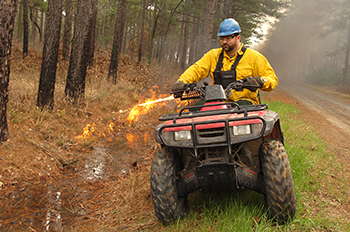
The burn plan objectives will be completed by using types of fire patterns that are suited to the fuel, weather, and topographical conditions.
Typically, a drip torch is used to start prescribed burns.
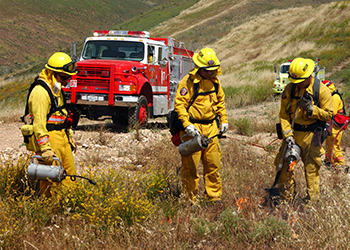
Monitoring Following a Prescribed Fire
Because prescribed burning is objective driven, there must be some initiative to measure success or failure. Efforts must be made to monitor whether or not objectives are being met.
This monitoring can be simple or scientifically rigorous. For example, if a quick survey for bobwhite quail does not yield any birds, a shift in burn prescription might be necessary.
Likewise, if results from a burn are yielding desirable results, no change in the prescription are needed. If trees are the objective, mapping fire severity is important to access the success of a burn management plan.
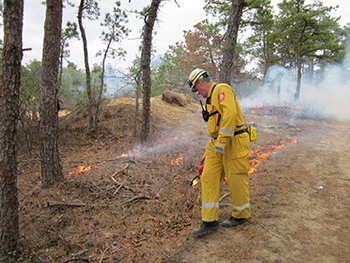
Forestry in Balance Part 1
Watch A Forestry in Balance Part 1. You will need the information in this video to the complete the task 3.04 Forest in Balance Part 1.
Questions to Ask
How do we evaluate the success or failure of a prescribed burn?

These are the questions to ask:
- Were the objectives stated in the burn plan achieved?
- How did the fire affect vegetation, soil, air and water?
- Was the smoke dispersion kept at a level that did not interfere with local urban areas?
- Was the burn plan followed? Could any changes be made in the future?
- Were there any escapes from the fire?
- Were the environmental conditions conducive the day of the burn?
- Were the costs commensurate with the benefits derived?
Smoke Management
Managing a prescribed fire is more than managing the flame. Prescribed fires also produce smoke. Those conducting prescribed burns must be prepared to “own their smoke.” Owning your smoke means developing a plan that considers sensitive areas.
Smoke can reduce visibility in key areas (such as high ways and airports) and emit particulates that can be an irritant to certain people. A smoke screening system should be used by all prescribed burn managers to identify smoke sensitive areas and select a strategy to minimize the impacts of the smoke.

There are many factors influencing the behavior of smoke. These factors include:
- fuel - type, volume, moisture, content, and arrangement;
- weather conditions;
- topography; and
- ignition patterns.
Liability
Under Alabama law, prescribed burners have a legal right to burn.
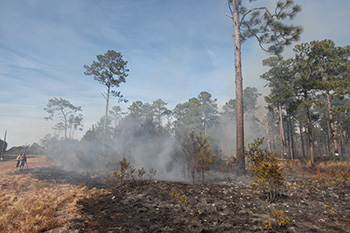
Successful lawsuits only occur when the prosecutor can prove negligence on the part of the defense.
Specifically, negligence can be effectively argued when a prescribed fire escapes control, produces smoke that causes physical damage, or produces smoke that causes or contributes to accidents.
Although voluntary, becoming a Certified Prescribed Burn Manager with the state of Alabama shows that extraordinary measures were taken to become trained in the safe and prudent use of prescribed fire.
Sensitive Areas
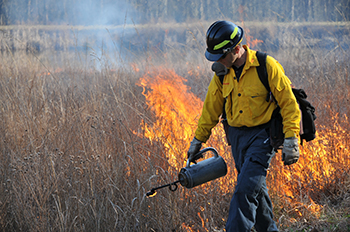
Examples of sensitive areas to avoid in prescribed burns:
- Interstate highways
- Highway bridges
- Hospitals
- Airports
- Nursing homes
- Schools
- Childcare centers
- Urban areas
- Chicken houses
- Housing subdivisions
- Hog Parlors
- Wilderness areas
- Dairies
- Scenic overlooks
- Recreation areas
- Peeople with respiratory problems
Fire Break

A fire break is a natural or constructed area used to check or control a fire.
Forestry in Balance Part 2
Watch A Forestry in Balance Part 2. You will need the information in this video to the complete the task 3.04 Forest in Balance Part 2.